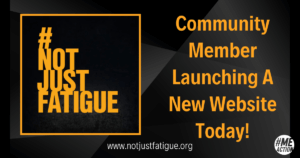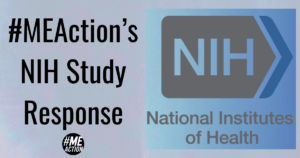Update: The video of Dr Nath’s talk is now available on youtube.
Dr Avindra Nath, Chief of the Section of Infections of the Nervous System at NINDS, gave a presentation on February 16 at CDC Grand Rounds going which went into detail on NIH’s new intramural ME/CFS study. The recording should be up on February 18 at http://www.cdc.gov/cdcgrandrounds/, but in the meantime we wanted to share a transcript of his talk, along with screenshots of his slides. Thanks so much to Kati and Mango at Phoenix Rising for taking screenshots and creating a voice recording, and to an anonymous #MEAction volunteer for help with the transcript! The synchronization of text with slides is a best guess for now and will be updated when the full recording is up on CDC’s website. At the end of the post is a transcript of the Q&A at the end of Grand Rounds.
Transcript and slides:
“Thank you very much for inviting me to speak at the CDC Grand Rounds and it’s a pleasure to talk about our planned study at the National Institutes of Health.
So as some of you know the National Institutes of Health has had a long standing interest in Chronic Fatigue Syndrome – in December of 2014 NIH sponsored a Pathways to Prevention workshop to advance research on ME/CFS. In September 2015 Dr Francis Collins who is the director of NIH tasked the intramural program to develop a research protocol to study the illness using the unique resources that are available at the intramural program.”

“The relationship of infections to the onset of ME/CFS and the large body of literature identifying a variety of interesting but inconsistent immune abnormalities in these patients provide a rationale for further studies of immune regulation. For example two studies from a group in Norway showed delayed clinical improvement in patients following treatment with Rituximab which is a monoclonal antibody that depletes B cells. However these studies were small and the immune profiles were not measured in these patients.”

“So as we’ve heard patients with ME/Chronic Fatigue Syndrome can be associated with a variety of precipitating factors. Our studies will be focused on a defined subset of patients who have a viral illness at onset of their illness and these patients are likely to have quite similar immune profiles. Our hypothesis is that Post infectious ME/CFS is triggered by a viral illness that results in immune-mediated brain dysfunction and to address this we have proposed a three phase study. The first Phase is a cross sectional study which will define the phenotype and the pathophysiology of the disease. Phase two will validate the biomarkers and a longitudinal study and phase three will be an early phase intervention trial to target the biomarkers identified in phase two.”

“So for the purpose of this talk I’m going to focus on phase one– and the first aim of this study is to define the clinical phenotyping using in-depth assessments of all domains of the illness as listed here.”

“Aim two of the study is to define the physiological basis of fatigue using functional MRI scan of the brain to define the brain circuits that are involved. Do detailed metabolic studies in a metabolic chamber and do transcranial magnetic stimulation as well as very detailed autonomic testing. Each of these tests will be performed before and after exercise.”

“The third aim of this study is to conduct a detailed immunological study in blood as well as cerebral spinal fluid including a screen for autoantibodies to neuro antigens. We will also fully explore the gut and oral microbiome and apply proteomics and metabolomics approaches to the cerebral spinal fluid.”

“The fourth aim of this study will utilize a variety of novel approaches to explore whether cells or serum from patients can be used to experimentally reproduce some of the features of the illness. We will determine if there is an inherent metabolic abnormality in neurons derived from stem cells and culture from these patients and if exposure of spinal fluid will induce the functional abnormalities in these cells. We will also generate humanized mice using blood cells from patients and determine of the clinical phenotype can be reproduced in these animals. If these experimental systems are able to reproduce the clinical or biological abnormalities seen in these patients, it would be a major step towards identifying the cause and the pathophysiology of the illness and for developing a variety of treatment approaches to these patients.”

“So for the purpose of our phase one study, we plan to recruit patients primarily from well characterized cohorts– particularly the CDC’s M CAM study described earlier by Dr Unger. Selection criteria will include documentation of the acute onset and duration of fatiguing illness for more than 6 months but less than five years. All patients will have post exertional malaise and full criteria of the 1994 research case definition and the Canadian Consensus Criteria as mentioned earlier. The study population will include 40 Post infectious ME/CFS patients, 20 healthy controls, 20 Post Lyme Disease patients who are asymptomatic – that means they do not have fatigue and 20 patients with Functional movement disorders.”

“These studies are still being refined and rely on the talent and expertise of a large number of investigators listed here. I would like to particularly thank Dr Brian Walitt who is the lead clinical investigator of this study at NIH and Doctors’ Unger and Lipkin as members of the executive committee for their valuable advice. The intramural program at NIH is looking forward to the new insights that will come from the concerted research into this illness. We expect that synergy between the CDC’s work, NIH intramural studies and researchers worldwide will allow therapies to be identified. Thank you.”
The following is a rough transcript of the very informative Q&A period– some of the questions were related to Dr Nath’s presentation and others to the previous presentations.
Dr Unger:
“Thank you very much we do have time for some questions – I would ask everybody to keep their questions brief so that we have time for our experts to answer them. And first Susan do you have some…”
Susan:
“Yes, from our online audiences. ‘Why is it the CDC and NIH’ ( ? Inaudible) ‘ pressure to bear on researchers and educating treating physicians to use far more extensive and detailed survey instruments and be far more precise in their description of the symptom presentation and pathogenesis’.”
Dr Unger:
“Ok – um I think that we are publicizing the importance of using instruments to precisely characterize the illness and we are in the process of publishing the baseline results of the M CAM study which will absolutely specify the instruments that we’re using and how they can help in other studies. And I believe the … and we’ve been working with NIH and we’re going to be sharing a lot of the same instruments and approaches.”
Dr Nath:
“Yes – I agree so we are delighted to be able to share whatever information we have and to work very closely with the CDC as Dr Unger mentioned – to achieve those goals.”
Susan:
“Another of our viewers would like to know all the specific steps that are being taken to educate medical students in medical schools using the latest information from the 2015 Institute of Medicine ME/CFS report.”
Dr Unger:
“Ok – um – well we have just started our medical student curriculum as I mentioned through the Med Ed portal. Um – this incorporates – ah – so we started it before the 2015 but the educational curriculum that goes along with it gives the references for the IOM report. In addition we have our collaborative process ongoing – or it’s just being started – where we are trying to work with medical educators to find out what kind of materials they want and can easily incorporate into their classes. The advantage of the Med Ed portal is that it is online and – um – it is free for faculty and actually medical students can have access to it independently as well. So we think that will be a useful start”. (Inaudible) “the collaborative workgroup – um – is what we hope will also be giving us advice as to what will be most helpful.”
Wilhelmina Jenkins:
“Dr Nath could I ask you to be a little more detailed about the patient advisory committee – how you intend to incorporate patient input into the NIH study? And could I also ask – I don’t know if you have the answer to this – about external funding from NIH to other researchers on the outside possibly through RFA’s that might be developed.”
Dr Nath:
“Excellent question – I’m delighted to try and address both of them. So – firstly I think -ah – input from the patients is absolutely critical for any disease that you want to study. They’re the ones who really experience the symptoms and live it – ah – live with it from day to day. So – as physicians whatever input we can get from patients is very important through whatever mechanism it is. Any physician will tell you that you learn a lot more from talking to patients than you do from reading any kind of text book, journal, or whatever medical literature that is available. So – careful listening to patients is absolutely critical. So with that in mind – you know I grew up in the early AIDS epidemic – and I saw interactive with ACT UP and other patient forums whereby they had a great impact on the way disease was handled – treated – and moved the federal government to make changes at every level. And so – we understand the importance of it – and there are efforts underway to put that advisory group together. So – um you know people who are senior to myself want to look at it from all perspectives and put together a proper group that will address both the intramural/extramural things. So I think those efforts are underway and we are looking forward to that input.
With regards to extramural funding that’s again beyond my area of authority – and so I know there is a lot of interest in being able to make that happen, lot of advocacy groups have approached NIH with that effort, I think the heart is in the right place and all those things will be done. I think it’s probably just a matter of time before you’ll see all these things happen – but there’s no lack of interest in making that – ah – achieving those goals.”
Steve Monroe:
“Steve Monroe, associate director for lab science and safety. I have a question for Dr Nath: Given the consensus on the role of immune dysregulation in the symptoms of the disease, can you elaborate a little bit on the kinds of functional immune assays that you are projecting to do with the upcoming study?”
Dr Nath:
“So, I put together a panel of really outstanding immunologists to guide me, although I do consider myself a neuro-immunologist, there are people… every immunologist is not the same. People who specialize in B cells and T cells and NK cells, and so on and so forth. So what I did is call on Dr Neil Young who is an expert immunologist at NIH and Ronald Germain who is a National Academy of Science member so we sat and discussed various kinds of things. So, I think what we’re going to do is– we are going to collect a lot of lymphocytes, both from blood and from CSF. Initially we will be storing them and what we’ll be doing is looking at cell-free fluid in the CSF and the serum for not just a small number of cytokines– actually 1500 lysates-analytes, ok? So… but we want to be very, very comprehensive, and I’ve developed a proteomics assay in my own lab which will look at about at least 2500 proteins.
So when we look at those, that composite, I think it will be very clear to us what cell types may be dysfunctional in these patients and how we can subgroup those individuals. And that will then allow us to go back and now say, ‘Well this looks like an NK cell function, let’s look at it. Or this looks like a B cell function,’ because there’s just innumerable amounts of very time-consuming, tedious assays for each cell type that you could potentially do, or interactions between cell types. So, instead of doing that at the get-go on everything you could possibly think (of), I think that’s a good screening tool, and then we can focus on the real aspects that we think are really dysfunctional.”
Audience:
“Do you think primary care providers can offer appropriate services to Chronic Fatigue patients or would it be better for them to refer to specialists?”
Dr Komaroff:
“I would – I guess Dr Lapp and I can both – Yes I think primary care providers can provide adequate services particularly if they have people in ID, Neurology, back ups when something doesn’t add up. But primary care providers need to be better educated than most are currently.”
Dr Lapp:
“I would agree with that and as a primary provider myself and a former family physician and internist and pediatrician – we’re at the forefront – the family physicians , the family doctors are the ones who really see the majority of these cases first – not the specialists and so as Tony has pointed out it’s very important for these providers to be educated and know how to recognize patients when they walk in the door and I should point out that we found from previous studies done by the CDC that not only the primary providers but also the mid level providers are doing a lot of the diagnosing and initial treatment of patients too. So I think it’s very important to address that group of individuals.
While I have the microphone I would like to say that since the IOM report came out and the P2P report we have seen a great deal of movement from the government – the patients always want to hear that – that there is something being done and from my perspective working with this wonderful group I’ve seen a lot of movement on behalf of the CDC and the National Institute of Health and even some positive statements for Dr Francis Collins who seems to be supporting a movement for more research into Chronic Fatigue Syndrome – so – hope that’s good news to the patients.”
Question from Brenda Robertson:
” I’m a nurse at Emory and Grady my background is community health and divinity – and I want to know if there is anyone at the CDC or NIH or beyond looking at research in environmental triggers such as the chemical loads that have been added to the food industry, for instance the seventies and eighties like phosphates, fructose, citric acid and I wondered if anyone’s looking at it as serious triggers because this is a widespread illness.”
Dr Unger:
“We don’t have a specific focus on that, we are aware that there are environmental triggers in some patients but – it is something that we have in mind but we don’t have an active program in that right now”.
Dr Nath:
“At the intramural program we really don’t have that kind of expertise our focus will really be on immune dysfunction, but the samples will certainly be stored – so – I think once the extramural community gets involved that have expertise in those areas we’ll be delighted to work with them and provide them whatever resources we have – in sample – patient samples”.






6 thoughts on “Transcripts and Slides from Dr Nath's talk on NIH study”
This is great. Thank you so much for transcribing and posting it.
There is an MEpedia page about the study, collating what we know so far http://me-pedia.org/wiki/NIH_Post-Infectious_ME/CFS_Study
Well done!
Key question is whether the CDC even tracks ICD G93.3 for ME/CFS? CDC should track this to have better visibility to prevalence, and ideally would also track severity better and whether mainly brain fog only vs also pains etc since seems very likely many subset diseases to this syndrome. Now we need NIH RFAs for outside R&D since NIH does not have all the experts. They need to ramp this faster since millions are suffering daily, for decades, but at least they recognize this as real organic disease.
Yes!^ I agree completely.
CDC video has been posted:
https://www.youtube.com/watch?v=hRdn4A2SGic
Comments are closed.